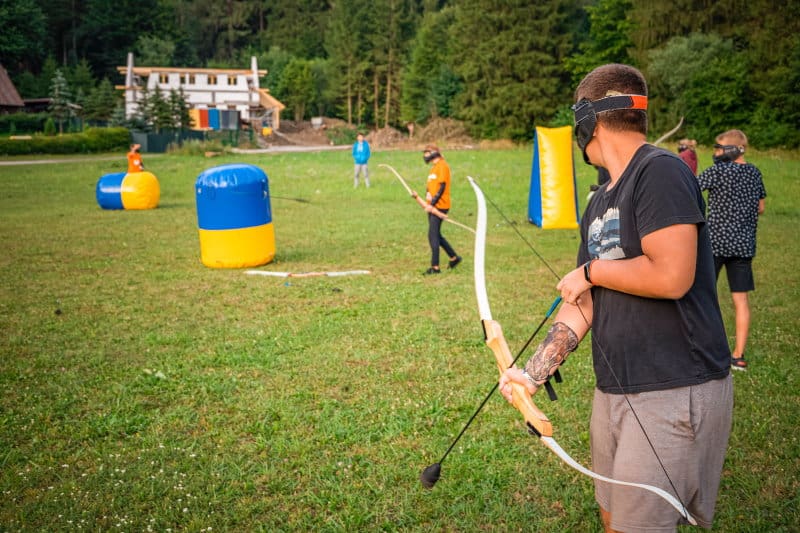If you’re getting into archery, chances are you’re confused with the number of techniques and different bows out there. For example, you may not be familiar with the term ‘canting a bow.’
Canting the bow is the act of holding your bow at a tilted angle rather than entirely straight. Archers usually do this to make their field of vision broader and clearer, accounting for more accurate shots.
Let’s get to know more about what is canting your bow and how it can be helpful.
What Is Canting a Bow?
To explain more, canting your bow means holding it with a slight tilt, so it’s a little less vertical when you’re drawing your bow for the shot.
Doing so widens your field of vision and helps you focus on your target. It also requires minimal movement, and with archery, minimal movements along with the correct stances are essential.
Some novice archers find themselves canting their bows because it simply looks cool. However, the bow cant is very common with professional archers, especially those who practice traditional archery.
Before we dig deeper into how to cant the bow, let’s get to know archery a bit more and how it has evolved.
How Does Canting Your Bow Help?

When you slightly tilt your bow, it keeps the upper part of the bow, or as it’s called, the bow limb, out of your way. Doing this can be very helpful if you’re a beginner because novice archers can find it difficult to pinpoint the target, so it helps clear your vision a bit.
Another thing that canting helps you with is maintaining the correct body posture. Beginner archers usually tend to make a lot of unnecessary movements and arch their backs more than necessary.
This can get fixed with time, but it can turn into a bad habit if not addressed early in training. With canting, you slowly learn to minimize unnecessary movements, get used to the right footing and posture, and focus more on hitting your target.
Now, of course, it’s no walk in the park, and it’ll take tons of patience and practice at different ranges to get to a reasonable level. However, you’ll gain muscle memory in the long run and get used to the right footing and posture.
How to Get Into the Habit of Canting
When it comes to getting used to bow canting, consistency, trial, and error are key.
The first step is to keep experimenting until you find the best angle that works best with your physique, eye alignment, and form.
If you’re wondering how you’ll figure out which angle is the best during your experiments, check where your fist points. After you’ve considered what we’ve just mentioned, whatever angle puts your arrow where your fist is pointing will be the best one.
Afterward, try to make your canting angle consistent. Of course, it can change by a few degrees depending on your field of vision and the target you’re aiming at. However, with practice, you’ll get the hang of the angles and how to align them correctly with the desired point of impact.
Why Does Bow Have to Be Level?

Chanting your bow too much or too little might make your bow a bit off-level. Therefore, it’s essential to consider your bow leveling when going for the shot. If you’re shooting without a sight, it usually takes a lot of trial and error to get the balanced canting angle that keeps your bow leveled.
However, because the technology did its thing, most modern bows come with sights with a level feature to help with accuracy. Aside from the wrong canting angle, strong winds might as well be a reason to throw off your bow level, and shooting on places like hills might be a factor too.
When shooting on a slope-like area, a lot of archers tend to lean more than required without realizing it. So always remember to be mindful of your footing and stance, use the level on your sights, and always take deep breaths.
Can You Cant Both Modern and Traditional Bows?
You can cant pretty much any bow you’re using for training. Canting has to do with your stance and angle while shooting; it doesn’t have much to do with the bow itself. So, whether the bow is an old recurve or a modern longbow, you can cant it just fine.
Let’s take a look at the difference between both.
Traditional Archery vs. Modern Archery
As we mentioned before, the most noticeable difference between traditional and modern archery is that it’s no longer just a means to hunt for your dinner. It’s now evolved into a sport that many practice professionally or just for fun.
Another difference between them is the difference in the bows. What was once a handmade instrument for hunting has now evolved with the latest materials. Most bows are now made mechanically.
For example, the traditional bow is an entirely handmade, simple, two-piece instrument made out of wood, with a string created from animal ligaments. On the other hand, the modern bow can be made of different materials like metal alloy or carbon, and the line is made of synthetic materials rather than animal ligaments.
There are a lot of different bows out there, but the two most common ones are the recurve bows and the longbows.
Recurve Bows Vs. Longbows
The most noticeable feature in a recurve bow is that its limbs are curved away from the shooter and not towards him. This bow is known for its shooting speed and intensity.
It’s also known for its easy handling and can come equipped with a lot of modern technology and materials. It can have carbon fiber limbs, and its riser can be made out of aluminum or carbon fiber as well.
An example of recurve bows is the Olympic recurve bow. This bow is a prime example of the evolution of archery, as it can be equipped with sights, a stabilizer, and a leveling feature.
A fun fact about recurve bows is that their name comes from their curved limbs. Because the limbs curve away from the shooter, the bow is called the “recurve.”
On the other hand, the longbow, also known as the D-shape bow, is more on the traditional side. Unlike the recurve bow, this bow has the classic “D” shape design, where the limbs curve inwards toward the shooter. To this day, the longbow is considered the most common and simplest bow to make. In ancient times, it was the go-to for everyone for hunting or self-defense.
Now that we’ve gotten to know more about archery and different kinds of bows let’s see how canting your bow can help with your learning process.
Conclusion
Whether your bow of choice is a traditional or a modern one, canting can definitely help with your aim and learning process. So go out there and practice, and remember to be patient in your journey!
If you want to get into bow hunting and know more about the details and costs, read here!

